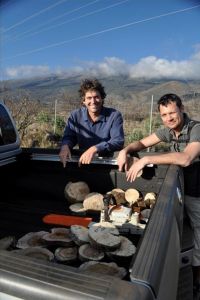Reconstructing pre-historic climate variability in Hawaiʻi and the tropical Pacific using tree rings
This project was comprised of two inter-related studies that focused on the annual growth rates of dominant native tree species on Mauna Kea volcano on the island of Hawai‘i. The goal of the first study was to build a tree-ring chronology from māmane (Sophora chrysophylla) to examine past trends in climate on Hawai‘i to better inform predictive models for climate change in the Pacific region. The goal of the second study was to build a long-term dataset on native Hawaiian tree growth and mortality (primarily ‘ōhi‘a, Metrosideros polymorpha, and koa, Acacia koa) that will be used to improve predictions about the future of old-growth forests on Hawai‘i and their role in both capturing and storing carbon.

In the first study, over 80 māmane samples were collected from high elevation areas and examined for annual growth rings. This will build on the chronology we have established, dating back 92 years, which demonstrates that these trees lay annual rings and that the ring-width is associated with amount of rain that fell during the previous summer. We are continuing to work on establishing a chronology that extends even further back in time.
In the second study, we found that old growth Hawaiian forests that have been fenced to exclude ungulates are quickly regenerating and adding significant amounts of above-ground biomass. Basal area for all tree species has increased, with the notable exception of koa, which has significantly decreased over the past 20 years. Our results demonstrate that introduced ungulates may have large effects on carbon cycling and forest dynamics in island ecosystems, but that management actions, such as fencing and ungulate removal, can reverse these effects. This study benefitted from the cooperation and guidance of Dr. Edward Cook, director of the Tree Ring Lab at the Lamont-Doherty Earth Science Center at Columbia University, as well as Dr. Gerd Helle from the Helmholz Centre, Potsdam Germany.
Management Applications and Products
This study integrated research and management by providing much needed information on the growth response of dominant forest tree species to climate variability and invasive species. This is of great importance to ongoing restoration projects such as the Mauna Kea Forest Restoration Project, run by the state’s Department of Forestry and Wildlife (DOFAW), as well as management efforts at Hakalau Forest NWR for a variety of rare and endangered Hawaiian bird species. Managers at Hakalau, for example, can move forward with expensive fencing efforts knowing that solid data exists demonstrating the beneficial long-term effects of fencing on forest dynamics.
The extended chronologies that will be produced in this study will have value to a wide variety of scientists interested in climate change in the Pacific, including climate and ecosystem modelers who need better information on past rainfall patterns for model validation purposes. Our data will also be important for land managers who need to better understand and prepare for how the unique high-elevation forests will respond to projected changes in climate, given the “backdrop” of past climate changes. In addition, our dendrochronology research will provide a database on the longevity of many tree species, and information on how tree age varies with habitat. This demographic information is critical to understanding the long-term dynamics of Hawaiian forests; yet there is currently little data regarding the lifespan of trees in these forests.
Outreach
This study has benefitted the local community by supporting students from under-represented groups in the STEM fields in all aspects of research. Kainana Francisco, Tishanna Ben, Joshua Pang-Ching, and Shea Uehana are native Hawaiian/Pacific Islander graduate students in the TCBES program at UH Hilo that were supported by this study and who have been absolutely central to our accomplishments so far. They have added a much-needed perspective to our work in this highly sensitive area. Other students who have been supported by and contributed to this project include William Ray, Mackey Bishop, Andrew Yoshimoto, Robyn Rector, and McKayla Meyer. They will continue to share the knowledge they have gained through this study with local K-12 school groups and college students.
In addition to the standard dissemination of information via public talks and published manuscripts, results from this work have also been spread through field trips. Graduate students associated with this project have been accompanied into the field by numerous student volunteers from UH Hilo. This has given these students first hand experience with data collection and management issues in different high elevation forests on Mauna Kea.
UH Hilo Stories: “Climate change research at UH Hilo: Tree rings and bird song”
2015 Publication: “Annual rings in a native Hawaiian tree, Sophora chrysophylla, on Maunakea Hawaiʻi”
Columbia University State of the Planet Blog: “Tree rings on Hawaii could hold new knowledge about El Nino”
Friends of Hakalau Forest Newsletter Article: “Twenty years of vegetation recovery following ungulate removal at Hakalau Forest NWR”
PROJECT DETAILS
FUNDED:
FY2013
PI:
Patrick Hart
Professor of Biology, UH Hilo

